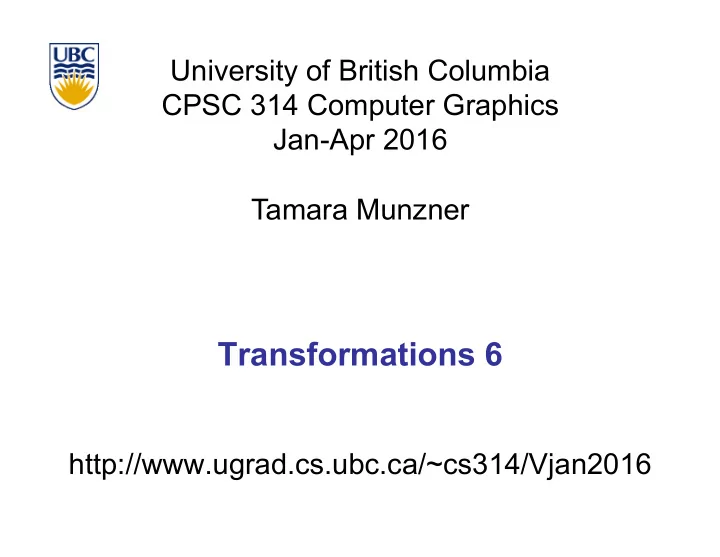

University of British Columbia CPSC 314 Computer Graphics Jan-Apr 2016 Tamara Munzner Transformations 6 http://www.ugrad.cs.ubc.ca/~cs314/Vjan2016
Transformation Hierarchies 2
Scaling and Rotating 3
Matrix Stacks • challenge of avoiding unnecessary computation • using inverse to return to origin • computing incremental T 1 -> T 2 Object coordinates T 2 (x) T 1 (x) T 3 (x) World coordinates 4
Matrix Stacks D = C scale(2,2,2) trans(1,0,0) pushMatrix() popMatrix() C D drawSquare() C C pushMatrix() C C scale(2,2,2) B B B B translate(1,0,0) A A A A drawSquare() popMatrix() 5
Modularization • drawing a scaled square • push/pop ensures no coord system change void drawBlock(float k) { pushMatrix(); scale(k,k,k); drawBox(); popMatrix(); } 6
Matrix Stacks • advantages • no need to compute inverse matrices all the time • modularize changes to pipeline state • avoids incremental changes to coordinate systems • accumulation of numerical errors • disadvantages • not built in to WebGL • but easy to implement with Array.pop/push • see also https://developer.mozilla.org/en-US/docs/Web/API/WebGL_API/Tutorial/ Animating_objects_with_WebGL#More_matrix_operations 7
Transformation Hierarchy Example 3 loadIdentity(); translate(4,1,0); pushMatrix(); rotate(45,0,0,1); translate(0,2,0); scale(2,1,1); F h F h translate(1,0,0); F 1 F h popMatrix(); F W 8
Transformation Hierarchy Example 4 translate(x,y,0); rotate(t1,0,0,1); DrawBody(); pushMatrix(); θ translate(0,7,0); 2 θ DrawHead(); 4 popMatrix(); pushMatrix(); translate(2.5,5.5,0); θ θ rotate( t2,0,0,1); θ 3 5 1 DrawUArm(); translate(0,-3.5,0); y rotate(t3,0,0,1); DrawLArm(); x popMatrix(); ... (draw other arm) 9
Hierarchical Modelling • advantages • define object once, instantiate multiple copies • transformation parameters often good control knobs • maintain structural constraints if well-designed • limitations • expressivity: not always the best controls • can’t do closed kinematic chains • keep hand on hip • can’t do other constraints • collision detection • self-intersection • walk through walls 10
Transforming Normals 11
Transforming Geometric Objects • lines, polygons made up of vertices • transform the vertices • interpolate between • does this work for everything? no! • normals are trickier 12
Computing Normals N • normal • direction specifying orientation of polygon • w=0 means direction with homogeneous coords • vs. w=1 for points/vectors of object vertices • used for lighting • must be normalized to unit length • can compute if not supplied with object P N 3 N ( P P ) ( P P ) = − × − 2 1 3 1 P P 1 13 2
Transforming Normals x ' x m m m T & # & # & # 11 12 13 x $ ! $ ! $ ! y ' y m m m T $ ! $ ! 21 22 23 y $ ! = z ' z $ m m m T ! $ ! $ ! 31 32 33 z $ ! $ ! $ ! 0 0 0 0 0 1 $ ! % " % " % " • so if points transformed by matrix M , can we just transform normal vector by M too? • translations OK: w=0 means unaffected • rotations OK • uniform scaling OK • these all maintain direction 14
Transforming Normals • nonuniform scaling does not work • x-y=0 plane • line x=y • normal: [1,-1,0] • direction of line x=-y • (ignore normalization for now) 15
Transforming Normals • apply nonuniform scale: stretch along x by 2 • new plane x = 2y • transformed normal: [2,-1,0] 2 2 0 0 0 1 # & # & # & % ( % ( % ( − 1 0 1 0 0 − 1 % ( % ( % ( = 0 0 0 1 0 0 % ( % ( % ( % ( % ( % ( 0 0 0 0 1 0 $ ' $ ' $ ' • normal is direction of line x = -2y or x+2y=0 • not perpendicular to plane! • should be direction of 2x = -y 16
Planes and Normals • plane is all points perpendicular to normal N • P = 0 • (with dot product) N T • P = 0 • (matrix multiply requires transpose) a x " % " % $ ' $ ' b y $ ' $ ' N = , P = c z $ ' $ ' $ ' $ ' d w # & # & ax + by + cz + d • explicit form: plane = 17
Finding Correct Normal Transform • transform a plane P = ' MP P given M, N = ' QN N what should Q be? N T ' P ' 0 = stay perpendicular T ( QN ) ( MP ) 0 = substitute from above T T (AB) T = B T A T N Q MP 0 = Q T N T P = 0 if Q T M = I M I = T thus the normal to any surface can be ( ) − 1 Q = M transformed by the inverse transpose of the modelling transformation 18
Recommend
More recommend